Going live with your SaaS: The Launch day
Table of Contents
This article is part of the series called Founders Guide which I’m writing currently to help early-stage founders tackle the problems they face during the first year of the startup.
As a startup founder, you need to be best friends with Murphy's law. Anticipate everything that can go wrong in the early days and try your best to steer clear of them. But not all challenges are predicted early—because not all challenges look like a big deal.
Take the launch day, for example. You have a solid website, people can't stop talking about your MVP in Slack and your roadmap looks clean. The only thing left is simply launching it to the wider people. Such a routine step, right?
Wrong.
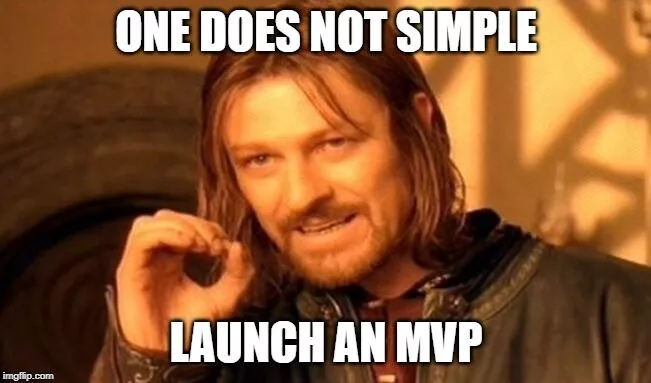
I have seen too many founders underestimate the launch day and even the practice of launching the product. Product launches give you the first taste of real users. If you can properly implement the learnings of the launch day, your app will be a success.
My experience says that launch day can go wrong in so many ways that even Edward A. Murphy wouldn’t predict them. Overconfidence kills a product on day 1, ignorance buries it forever.
I'll go over the launch day lessons I learned at a cost and lay out a step-by-step Product Hunt launch strategy to make the most of your opportunity. But first, the emotional toll.
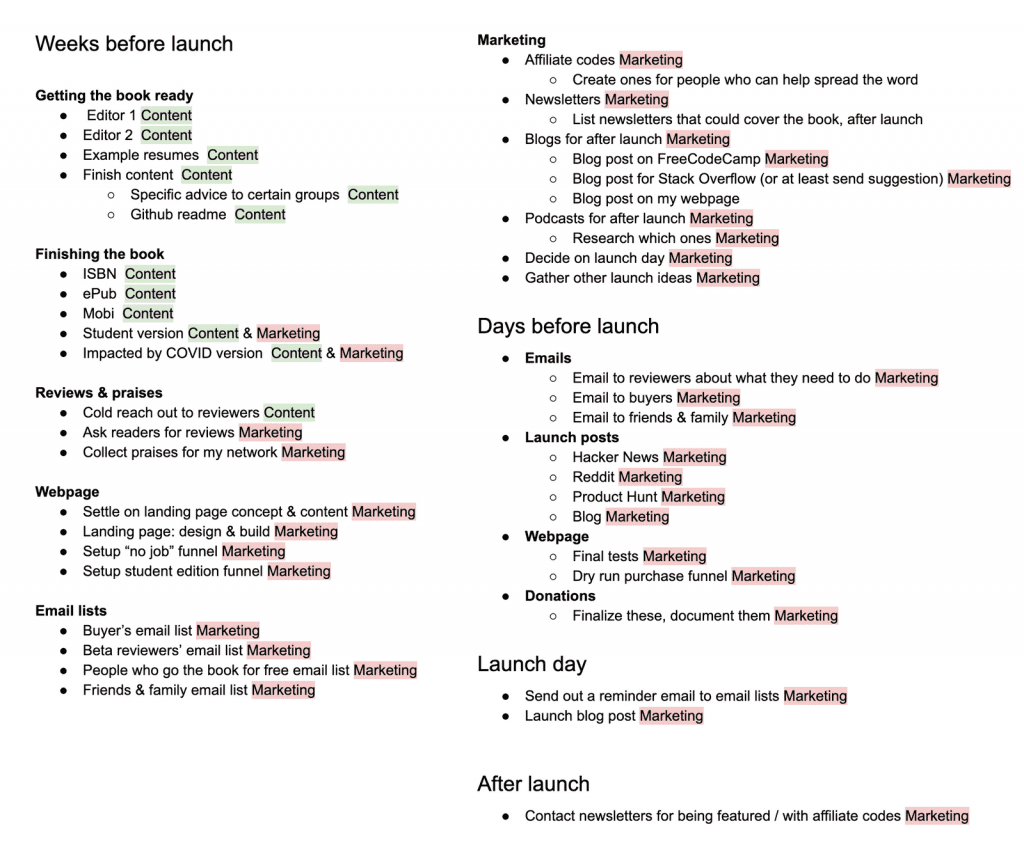
Product launch: a tale of two phases
Product launch is really about tasting waters—which can have two emotional sides for founders.
Stress paralysis
Putting your product out in the wild is intimidating. You are much more in control of the conversation in the MVP stage, but public opinions can be wild. As such, many founders want to put the absolute best version of the app forward.
They tinker, modify and tinker again, fixing things that aren't broken. I know what analysis paralysis can do to a product, and you should be aware of the trap. If your MVP is going great and your servers are ready to handle the influx of public users, go launch it. The best part of product launches these days is that you can launch continuously. New features, new versions, and new ideas are added all the time and you can even retarget old users with email newsletters and discounts.
The rude shock
If being too prepared can hurt you, so will unpreparedness. You weren't ready. The product was taken apart in startup communities. Now you don't know what to do. Undue criticism can put off even the strongest minds. Just be aware of this side of launches and prepare yourself as much as you can. Remember that the bulk of the negative comments online is not about the post itself. Take the good part, chin up and move on.
I feel it's important for founders to know the two psychological traps of launch day. Now that you know what to expect mentally, let's move on to the next step.
Preparing for the D-Day
This step solely relies on you not letting stress and anxiety get in your way. Don't overdo these and follow only the essentials.
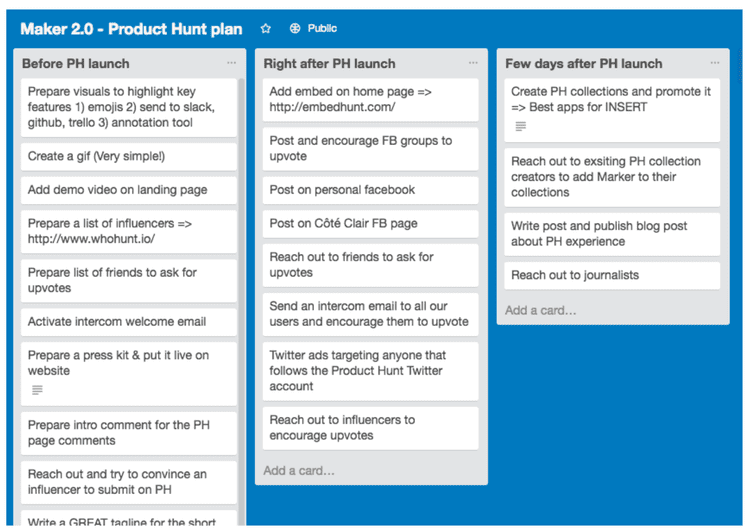
Here's how an example board may look like
Squash bugs
If you're ready for launch that means your MVP was successful. You have great feedback, the UX is good, the features are useful and people love using your product. Now put the finishing touches. Fix the new bugs, test user flow, and test some more. Get more eyes in and really make sure your app is ready for new users.
Create documentation and user onboarding experience
The early testers of your product will consist of tech enthusiasts and common users. Unlike MVP users, they don't know much about your offer. You may not have thought of it previously, but this is the time you get the documents right. Build an FAQ section, create onboarding material and be ready to support new users with helpful content.
Capture leads, take feedback
Your app/website must have two things: an email capture form and a feedback window.
Rarely will you find users as invested in your app as the early testers. Don't let them go. Offer product-related benefits and compel them to sign up for emails. Startups shouldn't build an email list of dedicated users — said no one ever!
Next, allow users to help you. At this stage, you might not be running with a 20-strong app development team. When you're doing most of the heavy lifting, some things are missed in the testing phase. If it's a bug or a feature that could be implemented, most users will love to notify you. Implement a feedback form where they can provide their opinions—some of them would be nice, and the others could be nasty.
Beyond the essentials, consider adding push notifications to your product and use analytics to see how it's performing.
Prepare your servers
Product launch brings new users, which increases server load. You cannot go into the day with the same server that's been handling MVP users. Generally speaking, Product Hunt will give you at least a couple of hundred simultaneous users and the total number can reach up to 10,000. If it catches the eyes of PR journalists, it will shoot up in no time. Be prepared for the traffic.
Time your launch
When you launch your product is as important as where you launch it. For instance, Product Hunt numbers reset every 24 hours, so the best time to launch there is 00:00 (12:00 AM) PST. Hacker News loves Zeitgeist. If your product can tap into the pulse of the raging conversations of today, you're in luck!
Timings differ according to the platforms you're targeting. But the point is, they do play a role in the success of your launch so find the ideal time.
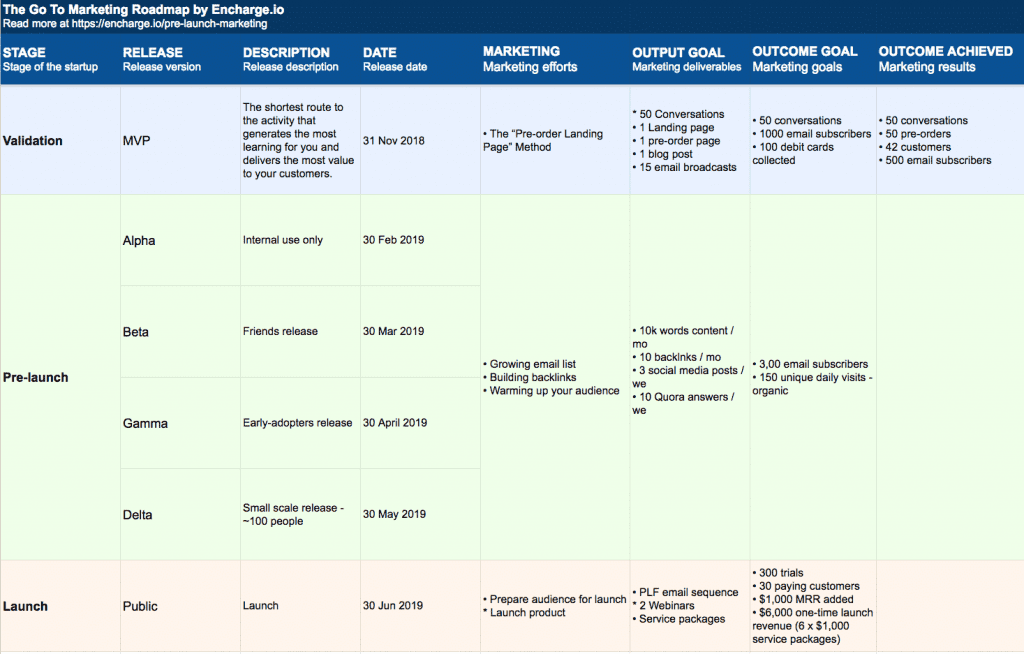
Source: Encharge.io
Places to launch
The rule of thumb is that you need to be where your customers are. If your target users are techies or B2B professionals, Product Hunt, Hacker News, and Reddit work best. If you're targeting movers and packers for your new app, find where they hang out. You should know your customers and the communities they visit. And launch there.
Generally speaking, I have seen great success with Product Hunt, Reddit, and Hacker News. Other places you can try are Indie Hackers, BetaList, Appsumo, and SaaSworthy.
Fun fact: focusing on only one platform for launch will not give you desired results. Try a multipronged approach.
Launching on Product Hunt
Product Hunt is the most sought-after platform for launches these days and it's not difficult to see why. It's filled with product enthusiasts, developers, and tech journalists. People are supportive, the leaderboards are transparent and the platform has a huge number of people visiting every day. If you have decided to do a Product Hunt launch, here's the rundown:
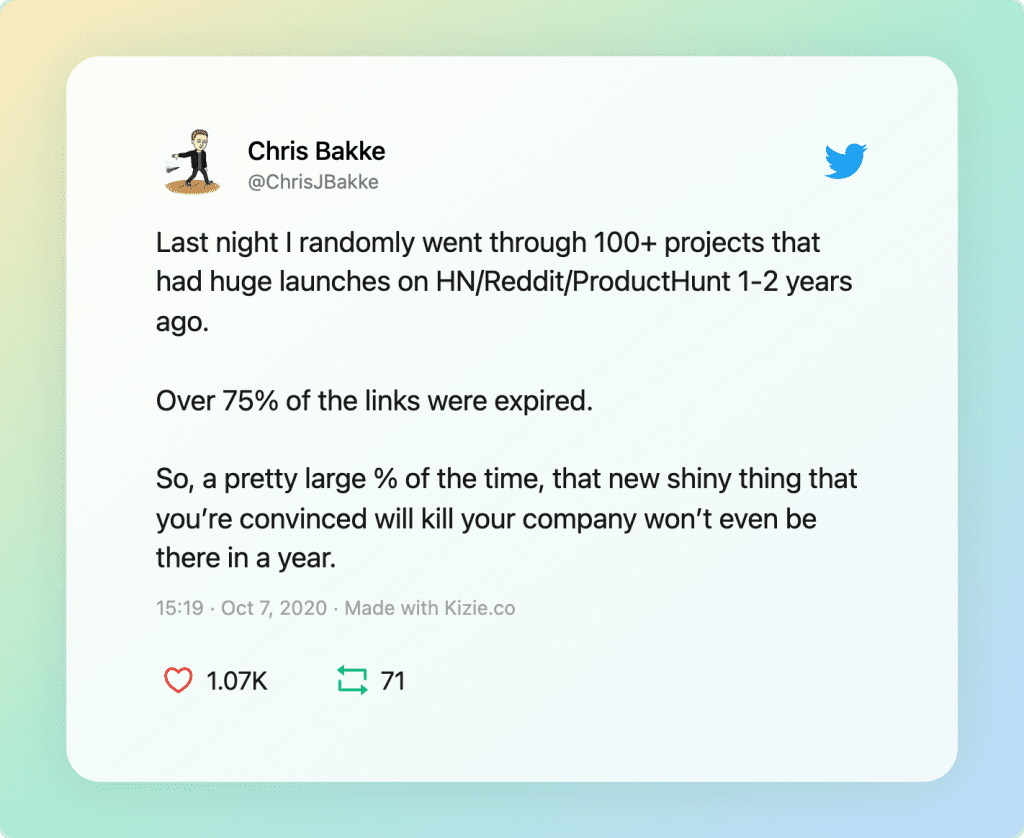
Get your visuals on point
As the founder, you may not have paid much attention to the exteriors before, but the first impression can outlast all your subsequent flaws. So make your product dress nicely.
Title and tagline that stops the scroll
First things first: write a good title and catchy tagline. If this is your first time launching, go with the product name. For the tagline, make it a catchy slogan that clearly explains the app and the value it brings. For example, I found this new app listed on Product Hunt called Hatchly. I can't comment on its quality or feature, but it uses a great tagline: "Install a loyalty program for small businesses in 1 click". It's simple, it's clear and it tells me what it's all about.
Avoid jargon, and focus on communication.
Thumbnails that pop
After readers are led by the copy, they'll look at the images. Use GIFS, videos, and images. Use an explainer video that can also be an app walkthrough recording. Alternatively use GIFS to screen record sections and definitely use screenshots and thumbnails as images. For me, 1 video, 4 images, or 2 GIFS, and 3 images are the sweet points. If your product requires more images to drive home the point, don't hesitate to put more.
A product description that surprises
Just below your title and tagline sits the product description. Imagine it as a bigger version of your tagline. It should be easy to comprehend, and if possible, delightful. For example, I again went back to Hatchly. Here's what the team wrote:
"We help to make your customers loyal without making you more busy. For free.
How it works:
* Set up your store in 1 click. If you want to configure it – you can!
* Print auto-generated QR code
* Let your customers know that you have it!
And that's it:)"
Sounds about perfect for small businesses that want to build loyalty programs with simple clicks.
Offer PH goodies
Before launching in Product Hunt, remember this: testers are doing you a favor in the early days. Make their stay worthwhile. Consider adding discounts for Product Hunt users to attract and retain them. When people are made to feel special, they tend to stick around. This is true for both relationships and startups. All you are doing at this stage is building relationships for your startup.
After the launch
What you do after the launch is equally important for the event's success. Once the product goes live, here are the things you must do:
Add a maker comment
Tell your story in the comments. People love to know the rationale behind a product or how the person is. Explain your bits and encourage everyone to share their thoughts. It works as a kickoff message and being warm, honest, and welcoming are so important here.
Tell it to the world
Once everything's in place in Product Hunt, spread the news. Make a Twitter thread, post on LinkedIn, set Facebook groups on fire—do whatever you can to drum up your launch. For me, asking people for upvotes is a grey area. If they love what you did, they'll definitely upvote you.
Your job is to bring the launch to everyone's notice and let the word of mouth move the leaderboard.
Be attentive (and kind)
Expect people to leave comments, be it on social media or in Product Hunt. Replying quickly and humbly is one of the best things you can do for your product. Help people understand what you're trying to do, how they can get the best out of the product, and every minor detail that can encourage them to try it out.
You don't have to be online 24/7, but being responsive in the initial few hours does help.
Reach PR outlets
Here's the thing: PR is not dead in 2022. Despite what people might make you believe, a little PR boost can do wonders. Product Hunt is usually filled with journalists from big PR firms but you can also reach them individually via cold email. Make it relevant and make it worth their time. Don't drag your outreach message too long. Tell them what you did, how it helps, and invite them to check it out. If your concept clicks with them, you now have a story.
That being said, big outlets can turn a story on its head, bringing needless negativity and attention to your product. It's important to not use PR as the core marketing strategy but to sort of plug the gaps. You can reach out to journalists from outlets such as WIRED, TechCrunch, Quartz, YCombinator, Entrepreneur, The Next Web, and LifeHacker to stir the pot. But eventually, only the organic interactions will decide your fate.
Launch day red flags
Despite following all the best practices, the launch day can still disappoint you. New founders often fall into these traps so take this opportunity to know about the red flags and how to avoid them.
Asking for share/upvotes
Product Hunt leaderboard is run by the upvotes (along with interactions, legitimacy, and their AI). It can be tempting to ask people to go upvote your product but the website has strong mechanisms to tackle voting manipulations. Asking to share or bump listings in Product Hunt, or Reddit doesn't do your image as an indie founder any good. It's not only futile but also counterintuitive.
Being absent in comments
Don't just launch and forget it. Be there to address queries and win over prospects. This is as much of a launch of a product as it is the personality of the maker. If you're genuine and charming, people will take a chance on your product, even if it has a couple of glaring flaws.
Spamming inboxes and social media feed
This again goes back to the practice of upvote farming. Do not stalk users and DM them on LinkedIn, Twitter, or basically any channel you find. Be respectful and let your app do the talking. If you have push notifications integrated into the product, remember to not spam users.
Taking it to heart
As I said earlier, launches can go south very soon. Don't take criticisms too strongly and try to focus on the problem. It can get disheartening after a barrage of negative comments but remember you did this to get a reality check. Treat this as tough love and move forward. You'll definitely need a hard shell if you're launching in Hacker News.
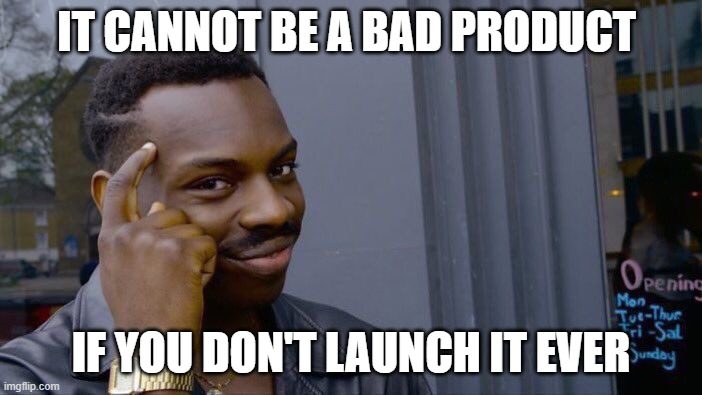
A launch is just the beginning
Product Hunt doesn't let makers launch the same app every day. If you have radical new features, consider launching them as a side project. You can gather feedback and bake it in the main app later. Alternatively, you can reach out to the Product Hunt team ([email protected]) to see if they'd allow the new version of the app to be launched again.
Be flexible
You'll learn a lot by launching your product. Some of these learnings might be shocking or unexpected. At this stage, it's important to be flexible with your product vision. See if the new approach to the product excites you. If not, let it go. Today's startup world moves at a breakneck speed and you cannot get stuck with an app.
Have backups
While working on your main project, consider keeping side project(s) alive. They will not only keep you mentally healthy but also allow you to pivot, if things go haywire.
Next steps
If you have read this far, you should now have a clear idea of launch days. They're not the biggest deals, but they're not something you should push aside. If you feel overwhelmed, take a step back and tell yourself it's just feedback from a few enthusiasts. But once you launch your product, be proactive and communicate with the community — they will become your champions.
-
Izzy
Launched a startup last year, aiming for disruption in the social media analytics space. Despite heavy prep and a hacker-news-worthy tech stack, the launch felt like yelling into the void. Realized too late that the build-it-and-they-will-come mentality is a Silicon Valley myth; user acquisition and growth hacking aren’t just buzzwords but survival strategies. Now, rather than celebrating milestones, I’m sifting through analytics dashboards, looking for a pivot before burn rate turns our startup story into a cautionary tale.
-
Starlord
Launching too soon or too late can hurt your startup. Find a good balance. User feedback is vital, use it to improve your product. Look beyond big platforms; niche communities can offer valuable insights. After launch, watch user behavior closely to adjust and improve your product.
-
Milo
The emphasis on Murphy’s law at the start really resonates. I’ve seen launches go sideways due to unexpected issues. The advice to prepare servers ahead of a launch is something many founders learn the hard way. Similarly, the strategy of leveraging multiple platforms for launch has proved beneficial in my experience, broadening reach significantly.
-
Kai
Launching a product is a big deal, and server capacity is crucial. I’ve seen launches go sideways because the server couldn’t handle the load. It’s also wise to launch across multiple platforms, not just the big names, to reach more potential users effectively. Don’t forget about leveraging personal networks and niche communities for better engagement. Simple steps like these can make a big difference in a launch’s success.
-
Rasmus
I learned the hard way that building a community before launching is crucial. I focused so much on the product and overlooked engagement with potential users early on. Starting conversations on social media or through newsletters not only gave me invaluable feedback but also created a base of supporters ready to spread the word on launch day. Seriously, never underestimate the power of a strong community behind your startup. It’s a game-changer.
-
Sven
The focus on Murphy’s law is a practical reminder for founders, highlighting the unpredictability of startups. Launch days are complex, yet so often underestimated. Through my journey, I’ve realized the importance of balancing preparation with flexibility. Pre-launch, it’s not just about squashing bugs but also about understanding user expectations and ensuring the infrastructure can handle new traffic. Post-launch, engagement with the community and responsiveness define the initial perception of your product. This article touches upon key strategies but remember, each startup’s journey is unique. Adaptation and learning from every bit of feedback, whether positive or negative, are crucial. Keep iterating and improving based on user insights.
